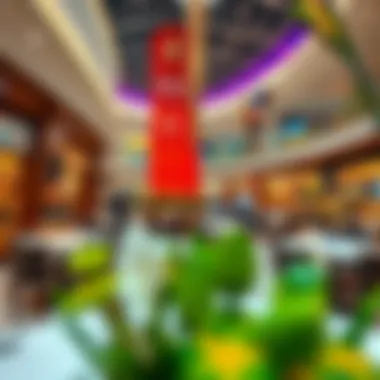Mall of the Emirates vs. Dubai Mall: A Detailed Insight


Intro
In the bustling metropolis of Dubai, two shopping giants loom large: the Mall of the Emirates and the Dubai Mall. Both of these monumental structures stand as beacons of luxury and entertainment in the heart of the city, each drawing millions of visitors annually. But as different as night and day, they offer distinct experiences that cater to diverse preferences and lifestyles.
This article embarks on a thorough exploration to compare these two shopping destinations, examining their architectural prowess, retail landscapes, dining options, and entertainment avenues. By assessing these factors, we aim to equip potential visitors and investors with vital insights into the unique characteristics of each mall, ultimately guiding informed choices in a city rich with opportunities.
Now, let's peel back the layers to reveal how each mall stacks up against the other in various facets that might sway your next visit or investment decision.
Preamble
Dubai has become synonymous with luxury shopping and extravagant experiences, particularly through its two flagship malls: Mall of the Emirates and Dubai Mall. These establishments represent more than just retail options; they are cultural landmarks and social hubs in their own right. Understanding the qualities of each mall is crucial for a number of reasons.
For investors, comparing these malls can reveal opportunities for retail development and engagement with high-end brands. The sector of high-street retail in Dubai is ever-growing; hence, recognizing the unique selling propositions of each mall can support informed decisions.
Furthermore, realtors and developers can benefit from understanding the demographic patterns drawn to each mall. Analyzing foot traffic, visitor preferences, and amenities provides deeper insights into potentials for future commercial investment.
Renters and homeowners may also find value in exploring these shopping meccas, as proximity to either can greatly enhance one's lifestyle livability. Access to varied retail and culinary experiences often drives home values in the surrounding neighborhoods. Buyers tend to place a premium on convenient amenities, making an exploration of these malls key.
In summary, this introduction not only sets the stage for a detailed comparison but also encapsulates the varied interests of diverse audience members. As we dive deeper into the specifics of these malls, you'll gain valuable insight into their offerings and decide which one aligns better with your personal aspirations or investment objectives.
Key Takeaway: The contrasting characteristics of Mall of the Emirates and Dubai Mall assign them distinct roles in Dubai's retail ecosystem.
As we unpack the historical context, architectural designs, retail experiences, dining options, entertainment offerings, and overall visitor demographics, it is vital to keep in mind the overarching significance these malls hold within the Greater Dubai area.
Historical Context of the Malls
When diving into a comprehensive comparison of the Mall of the Emirates and Dubai Mall, it’s essential to consider the historical legacies that shaped these monumental landmarks. Understanding how each mall came into existence not only provides context but also highlights the distinctive attributes that set them apart. The historical context illuminates the values, ideals, and ambitions of Dubai as it transformed into a global hub of commerce and tourism. Each mall's evolution reflects not just architectural innovation but also the socio-economic conditions leading up to their openings.
Origin of the Mall of the Emirates
The Mall of the Emirates opened its doors in November 2005, and it was not just another shopping center; it was a milestone for Dubai's retail landscape. Developed by Majid Al Futtaim Properties, it pioneered the concept of a mixed-use retail space that blended shopping, leisure, and entertainment under one roof. Located in the Al Barsha neighborhood, this mall represented a new wave sparked by Dubai's rapid economic growth in the early 2000s.
This mall wasn't simply designed for consumers; it aimed to create an experience. With 630 retail outlets and a staggering 85 million people passing through its doors annually, the Mall of the Emirates quickly became a lifestyle destination. The introduction of Ski Dubai, an indoor ski resort, further set the mall apart as it brought a unique attraction to a desert city. This imaginative idea catered not only to residents but also to tourists, fostering a culture of escapism – a crucial element in Dubai's identity.
Development of Dubai Mall
Opening its grand doors in 2008, Dubai Mall claimed the title of the largest shopping mall in the world, a testament to Dubai's ambitions on the global stage. Developed by Emaar Properties, its construction was part of the larger Burj Khalifa project, which aimed to position Dubai as a leading destination for travel and business.
After years of investment and planning, what emerged was jaw-dropping—a sprawling area housing over 1,200 shops, an aquarium, an ice rink, and an entertainment zone dedicated to children. Such offerings made the Dubai Mall more than just a retail space; it became a multifunctional hub for economic activity and entertainment. The mall's strategic location at the base of the Burj Khalifa symbolizes the intertwined growth of retail and real estate in Dubai, reflecting not only luxury but also the evolving tastes of a diverse clientele.
The development of these malls marks a pivotal chapter in Dubai’s quest for transformation—turning a bustling desert city into a global powerhouse bustling with commerce and culture.
The historical aspects of the Mall of the Emirates and Dubai Mall are fundamental to understanding their current positions in the market. They evolved from mere shopping destinations to cultural icons that embody the essence of Dubai's rapid growth and hospitality. This historical analysis helps investors and visitors alike navigate the complexities of urban development in one of the world’s most exciting cities.
Architectural Design and Ambiance
The architectural design and ambiance of a shopping mall greatly influence the overall visitor experience. They set the tone for what to expect, often dictating how one feels within a space. With the Mall of the Emirates and Dubai Mall being two heavyweight contenders in Dubai’s retail landscape, understanding their designs offers insights into their varying attractions and functionalities.
The importance of thoughtful design lies in its ability to create inviting environments that inspire visitors. A mall’s features can affect consumer behavior, making architectural considerations crucial for both developers and investors. From aesthetics to ease of navigation, these elements play a significant role in not only attracting foot traffic but also in enhancing overall satisfaction levels.


Exterior Features of Mall of the Emirates
The exterior of the Mall of the Emirates is striking, boasting an eclectic architectural style that mixes modern lines with a hint of Arabesque charm. Spanning over 2.4 million square feet, the façade is characterized by its sleek glass panels and a grand entrance. The mall prominently displays the iconic 'Ski Dubai' slope, visible from afar, which adds a unique twist to the otherwise commercial exterior. This captivating sight draws in curious visitors, sparking intrigue from the moment they see it.
Unsurprisingly, the mall has been conceptualized to reflect the region's identity while providing a contemporary shopping experience. The surrounding lush landscaping also contributes to a serene atmosphere, allowing visitors to escape the bustling city vibe. This blend of aesthetics has proven beneficial, as visitors often linger longer, increasing their overall spending.
Dubai Mall's Iconic Structure
Dubai Mall arguably reigns supreme when it comes to sheer architectural ambition. Sitting next to the Burj Khalifa, this enormous shopping destination reinforces Dubai's reputation as a global leader in luxury. The mall covers a staggering 5.9 million square feet, making it the largest mall in the world by total area.
What stands out is its dashing modernism mixed with traditional influences. For instance, the impressive glass atrium allows natural light to illuminate vast open spaces, creating a warm, welcoming environment. Furthermore, the multi-story waterfalls and the aquarium resembling a bridge highlight the grandeur and creativity embedded within its design.
The exterior features aren’t just about looks; they're functionally designed as well. The layout is intuitively crafted to guide visitors seamlessly through its multitude of attractions—from high-end stores to the Dubai Fountain and the VR Park. This kind of strategic design helps ensure that foot traffic flows smoothly, catering to a notable surge in visitors, especially during peak tourist seasons.
Interior Aesthetics of Both Malls
When it comes to interior aesthetics, both malls offer distinct yet captivating experiences. In the Mall of the Emirates, the interiors are elegant, with vaulted ceilings and high-end finishes that embrace luxury. The use of rich materials, such as marble and exquisite woodwork, adds an air of sophistication, making even casual browsing feel like a pampered affair. Specific areas are designed to invoke cultural themes, contributing to a heightened sense of place.
In contrast, Dubai Mall presents a more futuristic vibe, featuring minimalist design coupled with innovative elements. The spacious corridors, adorned with dynamic art installations, elicit a sense of awe among visitors. Each area is thematic, merging luxury shopping with world-class attractions seamlessly. For example, the proximity of the ice rink to the fashion avenue allows families to enjoy varied offerings without the need to trek across the expanse of the mall.
The ambiance within both malls is carefully curated. The lighting plays a pivotal role—soft, warm hues in the Mall of the Emirates create coziness, while the Dubai Mall’s bright, vibrant atmosphere is invigorating. Such contrasting approaches cater to diverse visitor preferences, whether one seeks tranquility or excitement.
For more insights, you might look into Wikipedia or Britannica.
Retail Experience
The retail experience within a mall greatly shapes not only the shopping habits of its patrons, but also their overall impression of the destination. For investors, realtors, and developers, understanding the strategic elements of retail can guide strategies for enhancing foot traffic and improving customer satisfaction. A well-crafted retail experience combines a diverse array of stores, exceptional customer service, and an inviting atmosphere, which collectively drive consumer loyalty. Thus, this section assesses how both the Mall of the Emirates and Dubai Mall approach these elements uniquely.
Diversity of Stores in Mall of the Emirates
Mall of the Emirates showcases a broad spectrum of stores, ensuring that there is something for everyone. Whether one is on the hunt for high-end fashion or quirky gift shops, the mall pulls it off with panache. Names like Harvey Nichols, Chanel, and Louis Vuitton sit alongside your more accessible brands like H&M and Zara. The variety provides a critical element of choice that draws in a diverse clientele.
Moreover, this mall is a hub for local boutiques, offering unique products not found elsewhere in Dubai. A stroll through its corridors can often feel like visiting a mini-international bazaar, where shoppers can uncover artisanal jewelry or home goods crafted by local artisans. This blend of mainstream and niche retailers enhances the overall shopping experience, creating a colorful tapestry of consumer offerings.
Retail Offerings in Dubai Mall
In contrast, Dubai Mall stands as the epitome of luxury retailing, boasting over 1,200 shops. Featuring brands such as Gucci, Dior, and Cartier, it caters primarily to upscale clientele looking to indulge in a high-fashion experience. The impressive selection goes beyond fashion; tech enthusiasts can explore a range of electronics at Apple and Samsung outlets, while art aficionados might find delight in galleries, setups, or exhibitions sprinkled throughout.
Furthermore, the mall incorporates innovative retail technologies, such as virtual reality experiences to test products before purchase, keeping it at the forefront of modern shopping. This forward-thinking strategy enhances consumer engagement, making retail visits not just about buying, but rather an inclusive experience.
Comparative Analysis of Luxury Brands
When examining luxury brands at both malls, discrepancies emerge in their positioning and availability. Mall of the Emirates, while housing some high-end labels, opts for a blend that appeals to multiple demographics—a tactic to ensure visitors from different backgrounds feel welcomed and catered for. It connects on a personal level with its audience. On the other hand, Dubai Mall serves as the playground for luxury aficionados. Its retail offerings can be described as curated— almost an exhibit of exclusivity, with flagship stores proudly displaying their collections. The ambiance here is different, too; it's meticulously designed, inviting you to step into a world where luxury reigns supreme.
"If you're after an experience that whispers luxury in every corner, Dubai Mall is your destination. However, for a more varied shopping experience, one might find Mall of the Emirates fitting the bill perfectly."
By analyzing the retail experiences of these two marquee destinations, potential shoppers can identify which aligns better with their personal preferences—whether it’s the vibrant variety at Mall of the Emirates or the luxury hub of Dubai Mall. Each mall has its own charm, weaving together a retail narrative that appeals to differing tastes and expectations.
Dining Options
Dining is often what makes or breaks a shopping experience. Both the Mall of the Emirates and Dubai Mall offer distinct culinary landscapes that cater to diverse tastes and preferences. In a city known for its opulence and variety, visitors can expect nothing less than an extravagant feast for the senses. The selection of dining establishments helps create a holistic shopping environment, where individuals not just shop, but also create memories around good food. This section highlights the diverse dining options available at both malls and explores how they enhance the overall visitor experience.
Culinary Diversity at Mall of the Emirates
The Mall of the Emirates boasts an impressive array of dining choices, representing flavors from around the globe. With over a hundred restaurants, cafes, and fast-food outlets, patrons are spoiled for choice. You can find a casual burger joint like Shake Shack, or indulge in refined cuisine at, say, the renowned French bistro, Le Relais de l'Entrecôte.


- Middle Eastern Delights: For those craving local specialties, restaurants like Al Hallab and Zaatar w Zeit serve up dishes that reflect the region's rich culinary heritage.
- Asian Flavors: Sushi aficionados can enjoy the fresh offerings of Tokyo Sushi, while a more diverse Asian experience awaits at the vibrant food court.
- Global Gourmet: Chains such as PF Chang’s and Tsujiri offer international takes on cuisine, making dining a memorable pause during the shopping spree.
Each outlet contributes uniquely to the mall's atmosphere, turning food into a social experience rather than just a necessity. Whether you’re hanging out with friends or enjoying a family meal, the dining scene here is lively, ensuring that guests feel right at home.
Gastronomic Experience in Dubai Mall
On the other hand, Dubai Mall takes dining to a whole new level. While it offers a staggering selection of over 200 dining venues, it also provides a setting that is as much about the visual experience as it is about the food. With views of the Burj Khalifa and the Dubai Fountain, dining here becomes part of an exclusive experience.
- High-Profile Restaurants: Renowned names like At.mosphere, located on the 122nd floor of the Burj Khalifa, provide a dining experience that's hard to rival, both in flavor and ambiance.
- Diverse International Options: From Mediterranean to Asian delights, venues like Chili’s and Din Tai Fung offer global culinary experiences for every palate.
- Luxurious Buffet Experiences: For those who like variety, the food courts impress with a concoction of international cuisines offered under one roof, along with the opportunity to sample numerous dishes.
In this big mall, food isn’t just about filling up; it’s about savoring. Visitors frequently comment on how the ambiance amplifies their meal, with the sights and sounds of Dubai adding an extra layer of enjoyment.
Comparing Food Courts and Restaurants
When it comes to food courts and standalone restaurants, both malls play their cards well, but with different strategies. In the Mall of the Emirates, the food court offers a cozy vibe, encouraging community dining. It feels informal, making it ideal for families and friends ready to refuel during their shopping outings.
- Favorite Eats in the Food Court: With familiar options like Burger King and KFC alongside local chains, it appeals to a broad audience.
- Restaurant Dining: In contrast, sit-down locations, often larger and more upscale, serve to elevate meal experiences, allowing for more intimate gatherings.
Meanwhile, Dubai Mall features sprawling food courts that mirror the mall's grandeur. They house familiar chains but also integrate lesser-known eateries, providing an exciting mix.
- Diner Experience: It often feels like you're at a global food expo, where new tastes await, and the seating can range from casual food-truck-style benches to luxurious lounges.
In this sense, dining experiences vary widely, from quick bites to laid-back meals, allowing each visitor to engage according to their own pace. A patron looking for speed can grab a bite in a food court, while someone seeking luxury can indulge at high-end establishments.
"Dining isn't just about food; it's about creating captivating moments that linger long after the meal is over."
For further insights into the dining landscape of Dubai, here’s a helpful resource: Dubai Dining Guide.
Whether you're looking to take a break or indulge in a culinary journey, it's crucial to choose a venue that suits your mood and taste.
Entertainment Offerings
The entertainment offerings in both the Mall of the Emirates and Dubai Mall add layers of allure, making them more than just shopping destinations. They serve as vibrant hubs where leisure meets excitement, drawing visitors from all walks of life. The significance of these aspects goes beyond mere distraction; they represent a crucial part of the overall visitor experience, emphasizing the role of malls in modern urban culture. As urban spaces evolve, these entertainment features offer respite, thrill, and social engagement, catering to various demographics, from families seeking activities to tourists looking for unique experiences.
Leisure Activities in Mall of the Emirates
Mall of the Emirates has carved a niche for itself with its wide array of leisure activities that blend luxury with excitement. Ski Dubai, an indoor ski resort, is a unique attraction that allows visitors to experience skiing or snowboarding in a desert city, bridging the gap between extreme sports and a shopping excursion. The facility features a snow park, giving families a playful atmosphere where snowball fights and snowman building are par for the course.
Visitors can also find Magic Planet, a family entertainment center that mixes arcade games and rides, offering something for everyone. Here, children can enjoy age-appropriate rides while adults might engage in competitive games. Plus, the cineplex is an excellent option for those who prefer to catch the latest blockbuster after a day of retail therapy.
In addition to these, the various art installations and events often hosted within the mall provide a cultural infusion, engaging visitors and creating a sense of community. Mimicking the vibe of art galleries, these installations rotate themes and are often local, allowing locals and visitors to appreciate the city’s artistic side.
Entertainment Attractions at Dubai Mall
Dubai Mall, on the other hand, doubles down on its attraction game with its aquarium and underwater zoo—one of the largest suspended aquariums in the world. This spectacle enables visitors to walk through tunnels surrounded by marine life, which can spark awe whether one is an avid marine enthusiast or not. The breadth of exotic species offers a glimpse into underwater ecosystems, all located beneath a bustling shopping environment.
Furthermore, Dubai Ice Rink provides a more leisurely pace, where visitors can glide across an Olympic-sized rink. It’s not just for skilled skaters; beginners can take lessons to learn how to skate, making it a fun family-friendly venture. The mall also features VR Park, an innovative virtual reality space that serves thrill-seekers looking for an immersive adventure that combines gaming with physical experience.
Moreover, the Dubai Fountain, set against the backdrop of the Burj Khalifa, offers dazzling water shows choreographed to a variety of musical tunes, making it a must-see attraction. Visitors can enjoy these performances from various vantage points around the lake, creating magical moments against the beautifully lit night skyline.


Visitor Engagement and Experiences
Engagement in both malls extends beyond just entertainment. At the Mall of the Emirates, visitors often cite the ease of navigating between activities, thanks to well-planned spaces and signage that guide them seamlessly from one experience to another. This is an essential factor in enhancing the overall enjoyment. The variety ensures that families with differing interests can spend a whole day without running out of things to do.
In Dubai Mall, the sheer volume of attractions can lead to sensory overload, but it also means there’s always something happening. Visitors have access to live performances, exhibitions, and seasonal decorations that reflect local culture and global trends, keeping the experience fresh.
It’s this blend of entertainment and shopping that positions malls as cultural touchstones for residents and tourists alike, elevating them into must-visit destinations as integral to the city’s fabric as any landmark.
To sum up, the diverse range of entertainment offerings at both malls caters to various interests and age groups, ultimately enriching the visitor experience. From indoor skiing in the arid landscape of the Emirates to stunning marine life displays in Dubai, these malls ensure there’s never a dull moment. As potential investors or visitors consider their options, these features illustrate how significant recreational opportunities can enhance the appeal and profitability of retail environments.
Visitor Demographics and Experience
Understanding the visitor demographics and experience is crucial when comparing the Mall of the Emirates and Dubai Mall. Both malls cater to a diverse clientele, but the nuances in their audience can reveal a lot about their appeal and operational strategies. This section highlights the key aspects of visitor profiles, how these contribute to the malls' unique atmospheres, and the expectations that come with such a visit.
Typical Visitors to Mall of the Emirates
Mall of the Emirates tends to attract a more mixed crowd. Its proximity to various residential areas makes it a popular spot for families and locals. You'll see parents with children enjoying the Ski Dubai slopes or indulging in entertainment options. Business professionals often drop by during lunch breaks, taking advantage of the retail therapy offered by a multitude of shops ranging from high-end boutiques to casual brands.
Moreover, the influx of tourists is hard to overlook, many of whom come seeking the thrill of a unique experience, especially the indoor skiing. This diverse visitor base combines with local inhabitants, creating a vibrant atmosphere where everyone from teens to retirees can find enjoyment in a multitude of activities.
Audience at Dubai Mall
Dubai Mall, being the largest shopping center in the world based on total area, distinctively attracts a different audience. It draws in not only tourists but also affluent guests and international shoppers eager to indulge in luxury shopping. With high-profile events like fashion shows and live concerts, it successfully engages both expatriates and high-end local clients.
The mall also hosts a wealth of attractions like the Dubai Aquarium and Underwater Zoo, appealing to families. On the other hand, art enthusiasts may gravitate towards various art exhibits hosted here. This unique mix leads to an upscale yet diverse audience, promoting a cosmopolitan flair. The environment changes drastically from day to night, bringing in a more glamorous crowd looking to enjoy dining and entertainment.
Visitor Expectations and Satisfaction Levels
When it comes to visitor expectations, both malls deliver to different degrees. At the Mall of the Emirates, expectations lean towards a balanced experience involving shopping, dining and leisure activities. Visitors often express appreciation for the friendly atmosphere and, importantly, the accessibility of various stores like Marks & Spencer or nearby IKEA.
In contrast, Dubai Mall sets a higher bar for expectations. Here, visitors seek a luxury experience paired with striking visuals. The shimmering fountains and vast corridors filled with world-class designer labels create an illusion of extravagance. Satisfaction levels appear more pronounced here, with many acknowledging the grandiose settings and variety as noteworthy.
However, crowds can also be an issue. Visitors at both malls emphasize the importance of ease of navigation as well as crowd control, especially during peak seasons.
In summary, understanding the various demographic profiles and expectations of visitors at both malls not only informs how each mall caters to its audience but also highlights the truth about consumer behavior in Dubai's retail landscape.
Ultimately, both malls offer distinct experiences that accommodate the evolving tastes and preferences of their visitors.
End: Which Mall Reigns Supreme?
When it comes to shopping, dining, and entertainment in Dubai, weighing the offerings of the Mall of the Emirates against those of the Dubai Mall is crucial for both visitors and potential investors. The essence of this comparison lies not only in evaluating physical attributes but also considering personal preferences, lifestyle choices, and investment potentials in a rapidly evolving marketplace.
Summary of Key Findings
In the investigation highlighted throughout this article, several distinguishing characteristics emerged:
- Retail Variety: Mall of the Emirates houses a unique blend of international brands alongside local boutiques, emphasizing a tailored shopping experience. On the other hand, Dubai Mall serves as a beacon for luxury and high-end shopping, featuring brands that cater to the affluent clientele.
- Dining Choices: Culinary options at the Mall of the Emirates reflect a more diverse cultural palette, making it ideal for family visits. In contrast, Dubai Mall skews more towards gourmet experiences, with many fine-dining establishments that showcase the best of international cuisine in a lavish setting.
- Entertainment: In terms of entertainment, Mall of the Emirates features the famed indoor ski slope which adds an unusual twist to its offering. Conversely, Dubai Mall boasts attractions like the Dubai Aquarium and the captivating fountain show, enhancing its appeal to tourists and families alike.
When considering these elements, one must think about their priorities. Are you drawn to a family-oriented atmosphere or more captivated by the extravagance of luxury retail?
Final Thoughts on Personal Preferences
Ultimately, the choice between the two malls boils down to more than just the numbers and features. Personal preferences shape how each individual experiences these iconic destinations. For instance, a shopper looking for variety in brands may find the Mall of the Emirates to be more appealing. Alternatively, a visitor eager to indulge in luxury may lean towards the Dubai Mall.
For residents and investors, understanding which mall aligns better with one’s values and lifestyle can influence potential rental yields or development opportunities in the surrounding areas. Both malls are masterpieces in their own right, catering to different segments of the market. Recognizing how these align with personal objectives can dictate not just shopping excursions but also investments in Dubai’s bustling economy.
"Choosing between the Mall of the Emirates and Dubai Mall isn't just about what they offer, but how they resonate with you personally."











